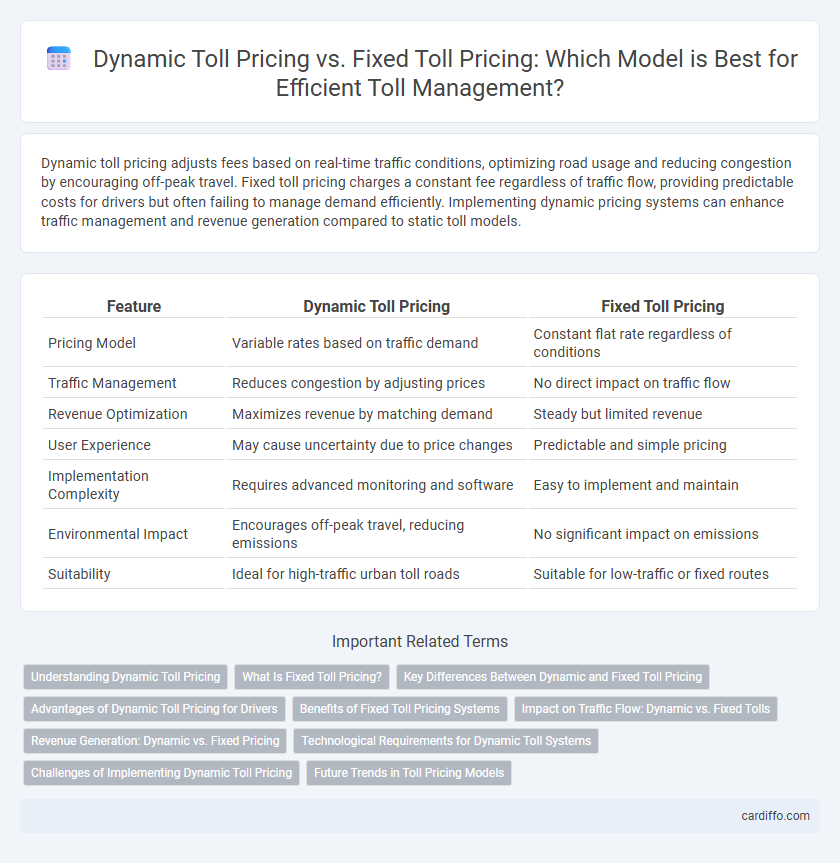Dynamic toll pricing adjusts fees based on real-time traffic conditions, optimizing road usage and reducing congestion by encouraging off-peak travel. Fixed toll pricing charges a constant fee regardless of traffic flow, providing predictable costs for drivers but often failing to manage demand efficiently. Implementing dynamic pricing systems can enhance traffic management and revenue generation compared to static toll models.
Table of Comparison
| Feature | Dynamic Toll Pricing | Fixed Toll Pricing |
|---|---|---|
| Pricing Model | Variable rates based on traffic demand | Constant flat rate regardless of conditions |
| Traffic Management | Reduces congestion by adjusting prices | No direct impact on traffic flow |
| Revenue Optimization | Maximizes revenue by matching demand | Steady but limited revenue |
| User Experience | May cause uncertainty due to price changes | Predictable and simple pricing |
| Implementation Complexity | Requires advanced monitoring and software | Easy to implement and maintain |
| Environmental Impact | Encourages off-peak travel, reducing emissions | No significant impact on emissions |
| Suitability | Ideal for high-traffic urban toll roads | Suitable for low-traffic or fixed routes |
Understanding Dynamic Toll Pricing
Dynamic toll pricing adjusts toll rates based on real-time traffic conditions, demand fluctuations, and congestion levels to optimize roadway efficiency and reduce traffic jams. Unlike fixed toll pricing, which charges a constant fee regardless of traffic, dynamic pricing leverages data from sensors, GPS, and traffic management systems to vary prices throughout the day. This approach encourages drivers to shift travel times or routes, ultimately balancing traffic loads and minimizing peak-hour congestion.
What Is Fixed Toll Pricing?
Fixed toll pricing involves charging a constant fee for road usage regardless of traffic conditions or time of day. This method simplifies toll collection and provides predictable revenue but can lead to congestion during peak hours. Fixed toll rates do not adjust dynamically to manage demand or optimize traffic flow on tolled roadways.
Key Differences Between Dynamic and Fixed Toll Pricing
Dynamic toll pricing adjusts rates based on real-time traffic conditions, demand fluctuations, and congestion levels, optimizing roadway usage and reducing traffic jams. Fixed toll pricing charges a constant fee regardless of time or traffic, offering predictability but often failing to manage peak-hour congestion effectively. The key difference lies in dynamic pricing's ability to incentivize off-peak travel versus fixed pricing's simplicity and stable revenue generation.
Advantages of Dynamic Toll Pricing for Drivers
Dynamic toll pricing offers drivers the advantage of reduced congestion during peak hours by adjusting rates based on traffic demand, leading to faster travel times and improved fuel efficiency. This pricing model encourages off-peak travel, providing cost savings for drivers who choose less busy times. Variable toll rates enhance overall road network efficiency, resulting in smoother traffic flow and a more predictable driving experience.
Benefits of Fixed Toll Pricing Systems
Fixed toll pricing systems provide predictable and stable revenue streams for transportation agencies, facilitating long-term infrastructure planning and budgeting. Consistent toll rates enhance driver satisfaction by eliminating uncertainty and allowing commuters to anticipate travel costs without fluctuations. This pricing model simplifies toll collection, reducing administrative overhead and supporting efficient traffic management across toll roads and bridges.
Impact on Traffic Flow: Dynamic vs. Fixed Tolls
Dynamic toll pricing adjusts prices based on real-time traffic conditions, effectively reducing congestion by encouraging off-peak travel and optimizing road usage. Fixed toll pricing maintains constant rates regardless of traffic volume, often leading to sustained periods of congestion during peak hours. Studies show that dynamic tolls improve traffic flow efficiency and reduce travel time variability compared to fixed toll systems.
Revenue Generation: Dynamic vs. Fixed Pricing
Dynamic toll pricing leverages real-time traffic data and demand fluctuations to adjust rates, maximizing revenue by charging higher prices during peak periods and lower rates during off-peak times. Fixed toll pricing sets a constant fee regardless of traffic conditions, often leading to underutilized capacity during low demand and missed opportunities for increased earnings. Studies show dynamic pricing can increase toll revenue by 20-40% compared to fixed pricing models, optimizing infrastructure usage and funding.
Technological Requirements for Dynamic Toll Systems
Dynamic toll pricing systems require advanced technologies such as real-time traffic monitoring sensors, GPS-enabled vehicle tracking, and automated payment platforms to adjust toll rates based on current traffic conditions. Integration of machine learning algorithms enables predictive analysis for optimizing toll charges and managing congestion effectively. Fixed toll pricing relies on simpler infrastructure with static pricing mechanisms that do not necessitate continuous data processing or dynamic rate adjustments.
Challenges of Implementing Dynamic Toll Pricing
Dynamic toll pricing faces challenges such as fluctuating traffic patterns that require real-time data processing and advanced algorithms for accurate rate adjustments. Infrastructure costs escalate due to the need for sophisticated electronic toll collection systems and continuous maintenance. Public resistance arises from perceived unfairness and complexity, complicating widespread adoption compared to the predictability of fixed toll pricing.
Future Trends in Toll Pricing Models
Dynamic toll pricing leverages real-time traffic data and artificial intelligence to adjust rates based on congestion, promoting efficient road usage and reducing delays. Future trends indicate an increasing shift towards integrated smart city infrastructure, enabling seamless communication between vehicles and toll systems for adaptive pricing. Fixed toll pricing remains prevalent on certain routes but is gradually being complemented or replaced by more flexible models to optimize traffic flow and revenue generation.
Dynamic Toll Pricing vs Fixed Toll Pricing Infographic

 cardiffo.com
cardiffo.com